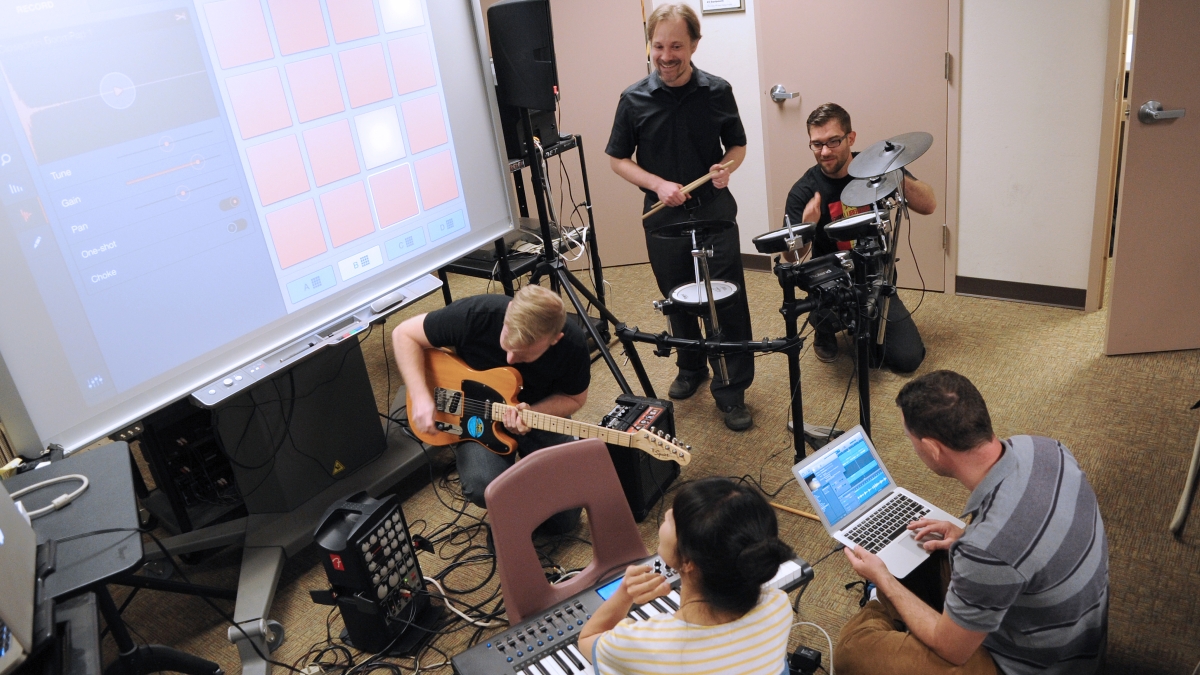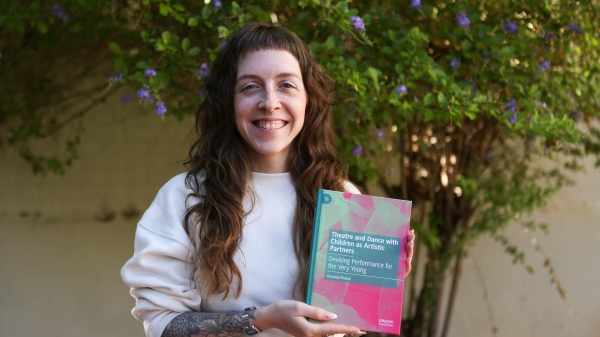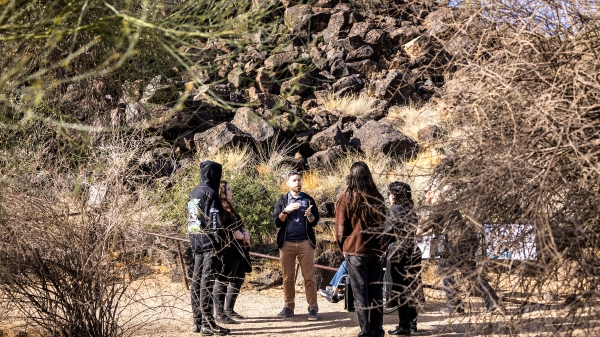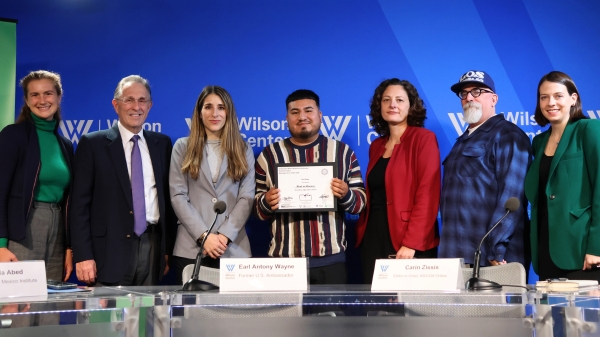School of Music wins $85,000 grant for music education project

ASU School of Music associate professor Evan Tobias (standing) collaborates with music education students and community members on beat making and jamming, two themes that will be addressed in the learning playlists. Photo by Tim Trumble, courtesy of the Herberger Institute for Design and the Arts
As part of the New American University, ASU’s Herberger Institute for Design and the Arts aims to embed arts-based study throughout the communities it serves locally, nationally and internationally, including investing in K-12 education through community partnerships, initiatives and faculty research.
Within Herberger Institute, the School of Music’s Consortium for Innovation and Transformation in Music Education (CITME) not only invests in those communities by conducting research to help music educators and advance music education, but also hopes to broaden and deepen how music teaching and learning can impact society and contribute to positive social transformation. Current research includes supporting connected learning in music education.
In recent years, educational leaders and organizations such as the MacArthur Foundation have promoted the idea of connected learning, which uses digital media to engage students and to enhance their learning by connecting their interests with their education. A report published by the Digital Media and Learning Research Hub said connected learning emphasizes issues of equity and capacity building to create opportunities for young people and encourages youth to learn with peers and adults by pursuing shared interests and goals.
Now, with an $85,000 grant from the sixth Digital Media and Learning Competition, with support from the MacArthur Foundation, School of Music associate professor Evan Tobias and the CITME are using these ideas to create six connected music learning playlists for educating youth through musical inquiry and in the context of artistic problem solving.
“The competition was a great fit for the Consortium for Innovation and Transformation in Music Education and our work over the past several years in exploring the potential of arts inquiry, engagement and learning to make a positive impact on young people’s lives, communities and society at large,” Tobias said. “This project is an exciting opportunity to weave together strands of research and creative work around connected learning, participatory culture, digital culture, learning and teaching and the capacity of music as a medium for people to be creative and expressive.”
Connected learning playlists are a curated group of learning experiences and resources such as videos, websites, books, games, articles and more. The different experiences are connected together to create one playlist that focuses on a theme and combines online, in-school, out-of-school and employer-based learning. The idea is to create a network of learning experiences and collaborative playlists where multiple organizations and providers may contribute. As more and more playlists are built, the connections across all learning experiences will continue to grow that learning network.
“Just as iTunes or Spotify playlists allow users to easily remix content across albums, connected learning playlists offer similarly personalized learning experiences,” according to the Digital Media and Learning Competition website.
For this project, called “Sound Explorations: Creating, Expressing and Improving Communities,” playlists will feature multiple learning pathways around six themes:
- Coding and programming music
- Making beats
- Building instruments and interfaces
- Producing music
- Connecting music and culture
- Jamming (solo and groups)
Each playlist’s multiple pathways will guide youth along experiences addressing National Core Arts Standards of creating, performing, responding and connecting through interest-based musical practices. The goal of the playlist set is to provide rich musical contexts that connect formal learning environments such as school music programs with community or after-school programs and informal settings such as homes or libraries.
Changing communities
Once the playlists are created, learners will use them to develop skills of inquiry, problem-solving and reflection from an artistic perspective relating to their interests. They will generate, develop, refine and share artistic ideas, and understand and evaluate music. In addition to emphasizing creativity and fostering musical inquiry, Tobias said the playlists will also encourage students to be change makers in society.
The music learning playlists will show students how to relate music to personal meaning and socio-cultural contexts as well as strengthen the students’ sense of selves as musical people who make a difference in their communities and society.
“While the focus of this initiative is curricular in nature, the goal of expanding access to music learning and supporting young people develop as creative expressive persons with potential to make a difference in their worlds serves as a driving force,” Tobias said.
Projecting all voices
“Sound Explorations” not only aims to inspire users to make a difference in their communities, but also plans to make sure those change makers include all voices.
“This project speaks to a key Herberger Institute for Design and the Arts aspiration of projecting all voices,” Tobias said. “The six music learning playlists will be designed to ensure that underrepresented people are featured so that all youth see places for themselves.”
The music learning playlists purposefully address aspects of musical engagement that are typically excluded from school music programs, according to Tobias.
“Our playlists will help music educators diversify opportunities for students in music programs and the approximate 78 percent of youth who lack access or opt out due to disinterest in the ensemble performance focus typical of most secondary programs,” he said.
Through the project partners, playlists will support after-school and community programs expanding access to musical engagement and learning opportunities, particularly in settings lacking access to experts or infrastructure.
Collaboration
Collaboration is at the heart of this project. Approaching the design of the playlists with principles of digital culture and participatory culture in mind means developers are casting the widest net possible to inform the development of music learning playlists. They plan to use crowdsourcing to gain perspectives and resources from people who have a passion for the topics of the lists or identify as practitioners in these areas.
Other collaborators include Alex Ruthmann at NYU, who has expertise in developing large-scale community learning initiatives and interactive digital media for musical engagement; the local community music organization Rosie’s House, which provides youth with free music lessons; the non-profit music organization Today’s Future Sound, which supports after-school beatmaking programs; the small entrepreneurial venture Sew Bright, headed by Ryan Bledsoe, a current music education doctoral student who is developing e-textiles and related opportunities for youth; three-time GRAMMY Foundation Music Education Award nominee and local teacher Richard Maxwell, who developed Arcadia High School’s Creative Musical Arts and Sciences program; and other music educators, teaching artists, community organizations and young people.
“We are excited to work with so many stakeholders and connect across the multiple contexts where young people learn and do music,” Tobias said.
More Arts, humanities and education

ASU professor explores theater, dance for young children in new book
Arizona State University Assistant Professor Amanda Pintore believes in the artistic capacity of very young children. She's…

Petroglyph preserve celebrates 30th anniversary with ancient, modern tales
The Deer Valley Petroglyph Preserve provides a beautiful walk through a pristine desert where chuckwalla lizards are as plentiful…

Kaleidoscope short film contest inspires powerful binational filmmaking in its second year
“We come to this country not to steal anybody’s jobs but to take advantage of the opportunities that the rest ignore. We’ve been…